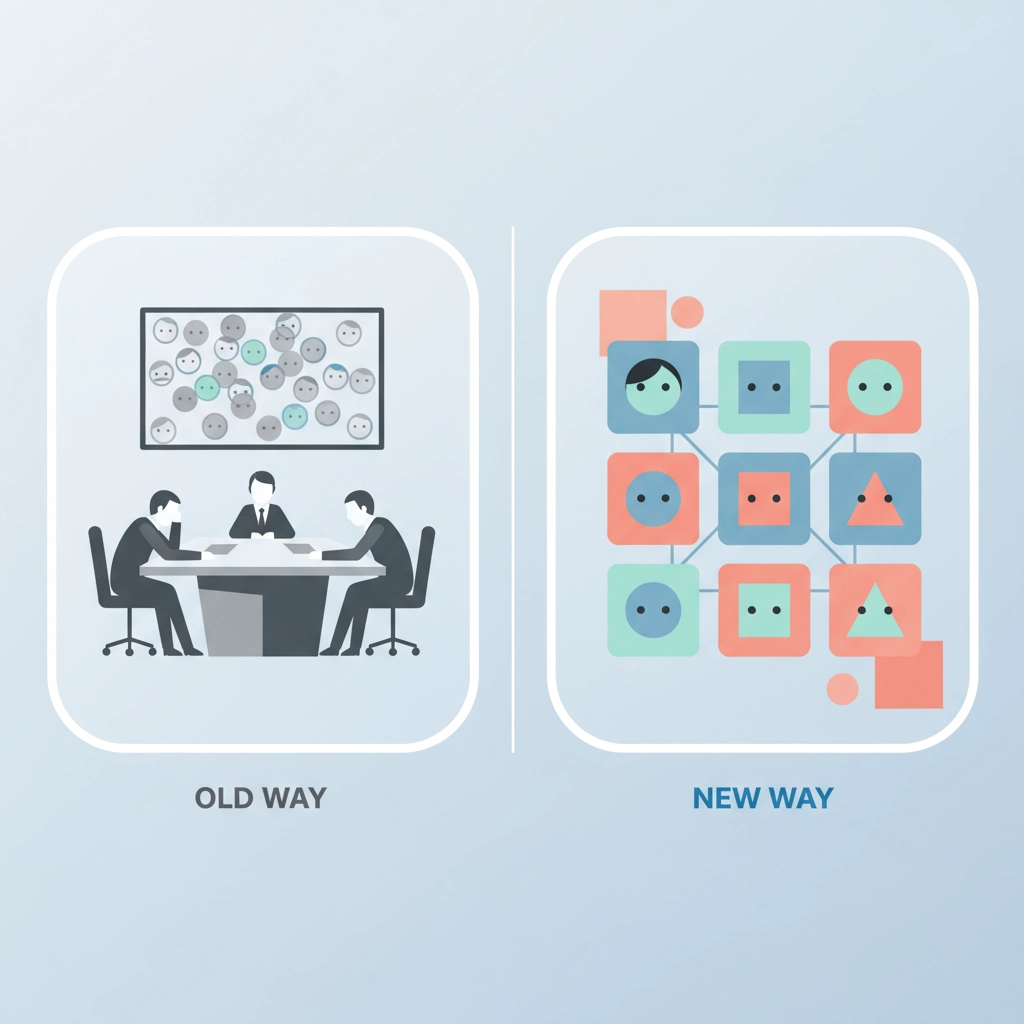Let's be honest: managing a hybrid team can feel like herding cats whilst blindfolded. One minute your remote workers are feeling disconnected and left out, the next your office team thinks the home workers have disappeared into the ether. Sound familiar?
If you're running a growing SME and struggling to get your hybrid workforce pulling in the same direction, you're not alone. The shift to hybrid working has left many leaders scrambling, and frankly, winging it with outdated management approaches just isn't cutting it anymore.
The good news? You don't need a complete organisational overhaul or a six-figure budget to fix this. What you need are smart, targeted leadership strategies that actually work in today's hybrid reality. Here are five proven hacks that'll transform your remote workforce chaos into a well-oiled machine: and you'll see results within 30 days.
1. Create Meeting Equality (Because Second-Class Citizens Don't Perform)
Here's the thing that's probably happening in your business right now: half your team huddles around a conference table whilst remote workers squint at tiny faces through a wonky camera angle, struggling to catch every third word. This creates an instant two-tier system where office workers get the full experience and remote workers feel like afterthoughts.
The hack: Make everyone dial in individually, even if they're sitting three desks apart in the office. No exceptions.
This might sound mad, but it's brilliant. When everyone joins the same way, nobody gets VIP treatment. Remote Sarah gets the same screen real estate as office Dave. Everyone's on equal footing, both literally and psychologically.
But here's where most leaders stop: and that's a mistake. You also need to increase your touchpoint frequency. That weekly team meeting isn't enough anymore. Remote workers drift out of sync faster than you think, and studies show isolated workers can see their performance drop by up to 20%.
Add a brief afternoon stand-up twice a week. Nothing fancy: just a 15-minute "where we're at" check-in. Aim for 2-3 team meetings per week with 2-3 days between each session. This keeps everyone aligned without turning into meeting hell.

2. Build a Strengths-Spotting System (Stop Playing Management Whack-a-Mole)
Most managers spend their time firefighting problems instead of amplifying what's working. This is particularly damaging in hybrid teams where good work often goes unnoticed because there's no natural opportunity for those "nice one, mate" moments by the coffee machine.
The hack: At every team meeting, get someone to share a specific story about a colleague who demonstrated your company values that week.
This isn't corporate fluff: it's strategic leadership. When remote Emma hears how her problem-solving skills saved the Johnson project, she feels seen and valued. When the whole team hears it, they understand what good looks like.
The key word here is "specific." Not "Sarah did great work this week" but "Sarah spotted the pricing error before it went to the client and saved us £15K and a very awkward conversation." Concrete stories stick, create positive momentum, and show your remote workers that their contributions matter just as much as the office crew's.
Research consistently shows that strengths-based leadership produces the highest employee engagement levels. In hybrid teams, this approach is absolutely critical because you can't rely on casual interactions to make people feel appreciated.
3. Kill Information Silos (Before They Kill Your Culture)
The biggest killer of hybrid teams isn't technology: it's the informal information flow that office workers get by default. The corridor conversations, the quick huddles, the "did you hear about the new client" chats. Remote workers miss all of this, and suddenly they're working with half the picture.
The hack: Document everything that matters and create dedicated information channels that work for everyone.
Set up a dedicated business updates channel in Slack or Teams. Every piece of company news, every client win, every policy change gets posted there first. Make it the single source of truth that both office and remote workers check daily.
But here's the crucial bit: train your office team to immediately document any spontaneous decisions or important conversations. That quick chat about changing the deadline? Post it. The casual mention of a new competitor? Document it.
Your remote workers shouldn't find out about key business developments secondhand. When people feel informed and included, they stay engaged and motivated. When they feel like outsiders, they start job hunting.

4. Schedule Strategic Face Time (Not FaceTime: Actual Faces)
Here's what many remote-first leaders get wrong: they think virtual communication can completely replace in-person interaction. It can't, and pretending otherwise weakens your team bonds.
The hack: Plan quarterly face-to-face sessions that aren't just social fluff but actual strategy and relationship-building opportunities.
This doesn't mean forcing everyone into the office every week. It means being strategic about when physical presence adds genuine value. Use these sessions for relationship-building, complex problem-solving that benefits from real-time collaboration, and reinforcing cultural touchpoints that don't translate well through screens.
Even your virtual meetings need a human touch. Start every call with genuine personal connection: not forced "how's the weather" chat, but real interest in how people are doing. Strong relationships form the foundation of effective collaboration, and this is even more critical when you can't rely on natural, informal interactions.
The goal isn't to recreate office culture virtually: it's to create something better that works for everyone, regardless of location.
5. Delegate Leadership (Because One Person Can't Manage Everyone)
Here's the uncomfortable truth: if you're trying to manage both remote and office workers as a single leader, you're probably doing both groups a disservice. Each segment has different needs, different challenges, and different communication preferences.
The hack: Create dedicated leadership touchpoints for your remote and office teams, either through promotion or fractional leadership support.
Look for natural leaders within both segments and give them official recognition and responsibility. This isn't about creating division: it's about ensuring everyone gets the attention and support they need to thrive.
Sometimes this means hiring dedicated managers. Sometimes it means promoting from within. And increasingly, smart SMEs are turning to fractional directors who can provide senior leadership expertise without the £150K+ commitment of a full-time executive.
The key is recognising that effective hybrid leadership requires more intentional management, not less. You can't just hope it works out: you need dedicated focus on both segments of your team.

Your 30-Day Implementation Plan
Week 1: Implement standardised virtual meeting practices and add your midweek check-ins. Everyone dials in individually from now on.
Week 2: Launch your strengths-spotting system and create your dedicated information channels. Start documenting everything.
Week 3: Schedule your first strategic in-person session and begin incorporating personal connection time into your virtual meetings.
Week 4: Assess your leadership capacity and make structural changes. Do you need additional management support? Now's the time to decide.
Throughout all four weeks, prioritise your team's wellbeing. Monitor workloads, provide mental health resources, and maintain clear boundaries between work and personal time.
The Bottom Line
The transformation won't be perfect after 30 days, but you'll have established the rhythms, rituals, and relationships that make hybrid teams genuinely effective. The key is deliberate cultivation: hybrid teams require intentional development so all staff, regardless of location, feel motivated, engaged, and aligned with your company vision.
These aren't just feel-good initiatives: they're business-critical strategies that directly impact your bottom line through improved retention, higher productivity, and stronger team performance.
If implementing these changes feels overwhelming whilst you're trying to run your business, remember that experienced fractional leaders have navigated these exact challenges before. Sometimes the smartest move is getting expert help to transform your team dynamics whilst you focus on growing your business.
The hybrid workforce isn't going anywhere; it's time to master it rather than merely survive it.


